Reconfigurable Single-/Dual-Wideband Bandpass Filters Based on a Novel Topology
Abstract
:1. Introduction
2. Operation Principle and Design
2.1. Transmission Poles and Zeros
2.2. Reconfigurable Properties
3. Design Examples
- (1)
- On the basis of DWB BPF with the widest bandwidth, initially determine the design para-meters of the passive filtering structure, i.e., Z1, Z2, Z3, Z4, Zoo, Zoe, θ1, θ2, and θ3.
- (2)
- Based on the different locations of first and third passband edges, determine CF and CT.
- (3)
- Based on the various locations of second passband edge, determine CS and θ3.
- (4)
- After slightly optimizing, obtain the final parameters.
3.1. Three Independently Tunable Passband Edges
3.2. Independently Tunable Center Frequency of Lower Passband with Fixed Absolute Bandwidth
3.3. Independently Tunable Bandwidth of Lower Passband with Fixed Center Frequency
3.4. Independently Switchable Lower Passband
3.5. Independently Tunable First Passband Edge of SWB BPF
4. Conclusions
Author Contributions
Funding
Conflicts of Interest
References
- Hou, Z.Y.; Liu, C.G.; Zhang, B.; Song, R.G.; Wu, Z.P.; Zhang, J.W.; He, D.P. Dual-/Tri-Wideband Bandpass Filter with High Selectivity and Adjustable Passband for 5G Mid-Band Mobile Communications. Electronics 2020, 9, 205. [Google Scholar] [CrossRef] [Green Version]
- Yang, L.; Gómez-García, R.; Muñoz-Ferreras, J.-M.; Zhang, R.-Q.; Peroulis, D.; Zhu, L. Multilayered Reflectionless Wideband Bandpass Filters With Shunt/In-Series Resistively Terminated Microstrip Lines. IEEE Trans. Microw. Theory Tech. 2019, 68, 877–893. [Google Scholar] [CrossRef]
- Lalbakhsh, A.; Alizadeh, A.M.; Ghaderi, A.; Golestanifar, A.; Mohamadzade, B.; Jamshidi, M.; Mandal, K.; Mohyuddin, W. A Design of a Dual-Band Bandpass Filter Based on Modal Analysis for Modern Communication Systems. Electronics 2020, 9, 1770. [Google Scholar] [CrossRef]
- Bi, X.K.; Zhang, X.; Huang, G.; Tao, Y. Compact Microstrip NWB/DWB BPFs With Controllable Isolation Bandwidth for Interference Rejection. IEEE Access 2019, 7, 49169–49176. [Google Scholar] [CrossRef]
- Bi, X.K.; Zhang, X.; Wang, S.W.; Yuan, T.; Guo, S.H. Design of Equal-Ripple Dual-Wideband Bandpass Filter With Minimum Design Parameters Based on Cross-Shaped Resonator. IEEE Trans. Circuits Syst. II Express Briefs 2020, 67, 1780–1784. [Google Scholar] [CrossRef]
- Mostrah, A.E.; Muller, A.; Favennec, J.-F.; Potelon, B.; Manchec, A.; Ruis, E.; Quendo, C.; Clavet, Y.; Doukhan, F.; Le Nezet, J. An RF-MEMS-Based Digitally Tunable SIW Filter in X-Band for Communication Satellite Application. Appl. Sci. 2019, 9, 1838. [Google Scholar] [CrossRef] [Green Version]
- Ohira, M.; Hashimoto, S.M.; Ma, Z.-W.; Wang, X.L. Coupling-Matrix-Based Systematic Design of Single-DC-Bias-Controlled Microstrip Higher Order Tunable Bandpass Filters With Constant Absolute Bandwidth and Transmission Zeros. IEEE Trans. Microw. Theory Tech. 2018, 67, 118–128. [Google Scholar] [CrossRef]
- Lu, D.; Yu, M.; Barker, N.S.; Li, Z.-Y.; Li, W.; Tang, X.-H. Advanced Synthesis of Wide-Tuning-Range Frequency-Adaptive Bandpass Filter With Constant Absolute Bandwidth. IEEE Trans. Microw. Theory Tech. 2019, 67, 4362–4375. [Google Scholar] [CrossRef]
- Khani, S.; Mousavi, S.M.H.; Danaie, M.; Rezaei, P. Tunable compact microstrip dual-band bandpass filter with tapered resonators. Microw. Opt. Technol. Lett. 2018, 60, 1256–1261. [Google Scholar] [CrossRef]
- Xu, J.; Wu, W.; Wei, G. Novel Dual-Band Bandpass Filter and Reconfigurable Filters Using Lumped-Element Dual-Resonance Resonators. IEEE Trans. Microw. Theory Tech. 2016, 64, 1496–1507. [Google Scholar] [CrossRef]
- Bi, X.-K.; Cheng, T.; Cheong, P.; Ho, S.-K.; Tam, K.-W. Wideband bandpass filters with reconfigurable bandwidth and fixed notch bands based on terminated cross-shaped resonator. IET Microw. Antennas Propag. 2019, 13, 796–803. [Google Scholar] [CrossRef]
- Zhang, B.; Li, S.-S.; Huang, J.-M. High performance tunable bandpass filter with separately reconfigurable passband edges. Microw. Opt. Technol. Lett. 2015, 57, 1111–1113. [Google Scholar] [CrossRef]
- Wang, X.M.; Bi, X.-K.; Guo, S.H.; He, J.; Li, C.L.; Liu, J.J.; Hu, G.Q.; Ma, G.J.; Xu, Z.-T. Synthesis Design of Equal-Ripple and Quasi-Elliptic Wideband BPFs with Independently Reconfigurable Lower Passband Edge. IEEE Access 2020, 8, 76856–76866. [Google Scholar] [CrossRef]
- Bi, X.K.; Zhang, X.; Wang, S.W.; Guo, S.H.; Yuan, T. Synthesis Design of Chebyshev Wideband Band-Pass Filters With Independently Reconfigurable Lower Passband Edge. IEEE Trans. Circuits Syst. II Express Briefs 2020, 67, 2948–2952. [Google Scholar] [CrossRef]
- Chuang, M.-L.; Wu, M.-T. Switchable Dual-Band Filter with Common Quarter-Wavelength Resonators. IEEE Trans. Circuits Syst. II Express Briefs 2015, 62, 347–351. [Google Scholar] [CrossRef]
- Lee, V.; Lee, S.; Sis, S.A.; Mortazawi, A. Intrinsically Switchable Frequency Reconfigurable Barium Strontium Titanate Resonators and Filters. IEEE Trans. Microw. Theory Tech. 2017, 65, 3221–3229. [Google Scholar] [CrossRef]
- Lu, D.; Tang, X.H.; Barker, N.S.; Feng, Y.K. Single-Band and Switchable Dual-/Single-Band Tunable BPFs With Predefined Tuning Range, Bandwidth, and Selectivity. IEEE Trans. Microw. Theory Tech. 2017, 66, 1215–1227. [Google Scholar] [CrossRef]
- Chaudhary, G.; Jeong, Y.; Lim, J. Dual-Band Bandpass Filter with Independently Tunable Center Frequency and Bandwidths. IEEE Trans. Microw. Theory Tech. 2012, 61, 107–116. [Google Scholar] [CrossRef]
- Wu, Y.; Nan, L.; Jiao, L.; Wang, W.; Liu, Y. Dual-band coupled-line bandpass filter with independently tunable bandwidths. China Commun. 2016, 13, 60–64. [Google Scholar] [CrossRef]
- Kumar, N.; Singh, Y.K. RF-MEMS-Based Bandpass-to-Bandstop Switchable Single- and Dual-Band Filters with Variable FBW and Reconfigurable Selectivity. IEEE Trans. Microw. Theory Tech. 2017, 65, 3824–3837. [Google Scholar] [CrossRef]
- Bi, X.-K.; Cheng, T.; Cheong, P.; Ho, S.-K.; Tam, K.-W. Design of Dual-Band Bandpass Filters with Fixed and Reconfigurable Bandwidths Based on Terminated Cross-Shaped Resonator. IEEE Trans. Circuits Syst. II Express Briefs 2018, 66, 317–321. [Google Scholar] [CrossRef]
- Simpson, D.J.; Gómez-García, R.; Psychogiou, D. Single-/Multi-Band Bandpass Filters and Duplexers with Fully Reconfigurable Transfer-Function Characteristics. IEEE Trans. Microw. Theory Tech. 2019, 67, 1854–1869. [Google Scholar] [CrossRef]
- Bi, X.K.; Zhang, X.; Wang, S.W.; Guo, S.H.; Yuan, T. Reconfigurable-Bandwidth DWB BPF with Fixed Operation Frequency and Controllable Stopband. IEEE Trans. Circuits Syst. II Express Briefs 2020. to be published. [Google Scholar] [CrossRef]


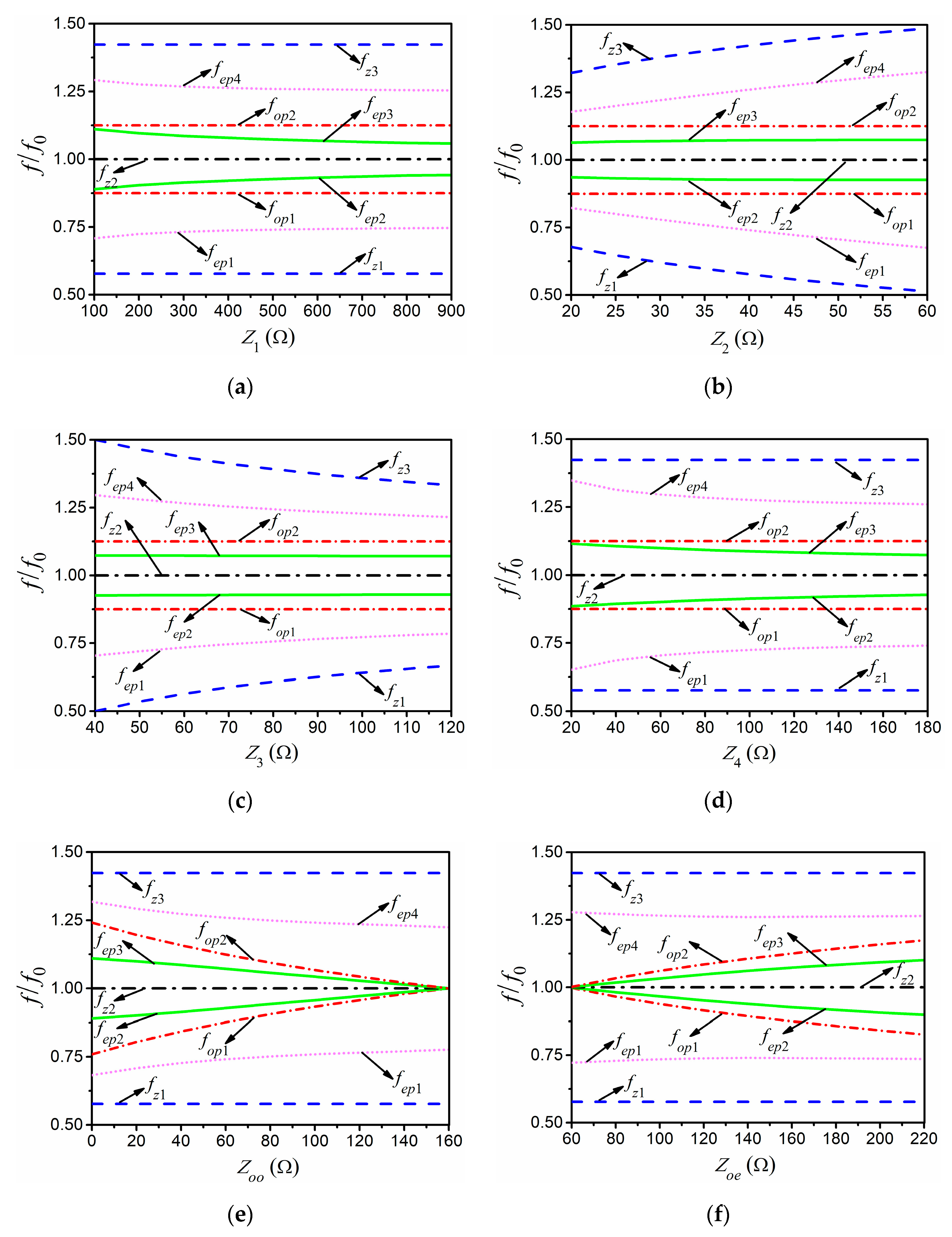

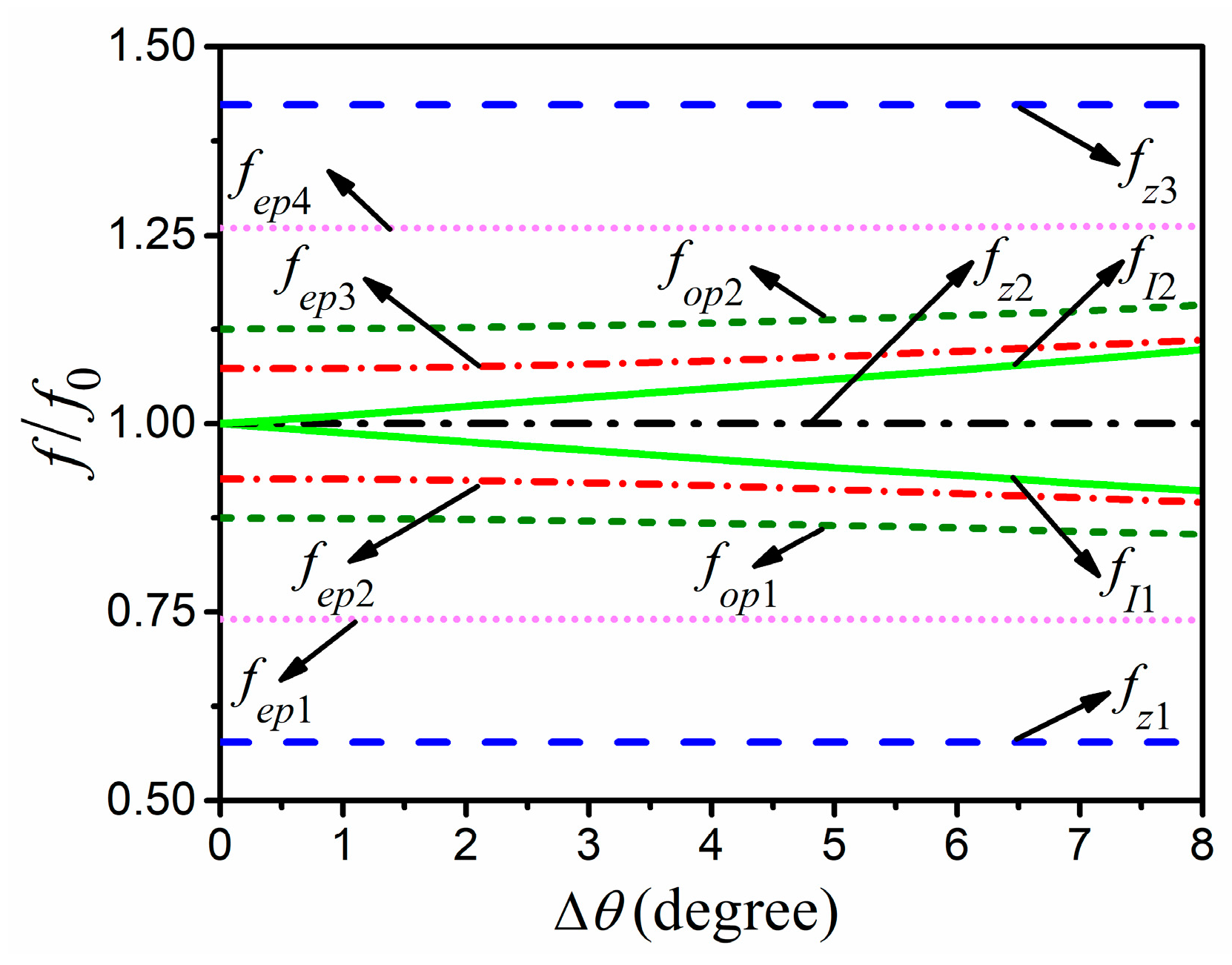
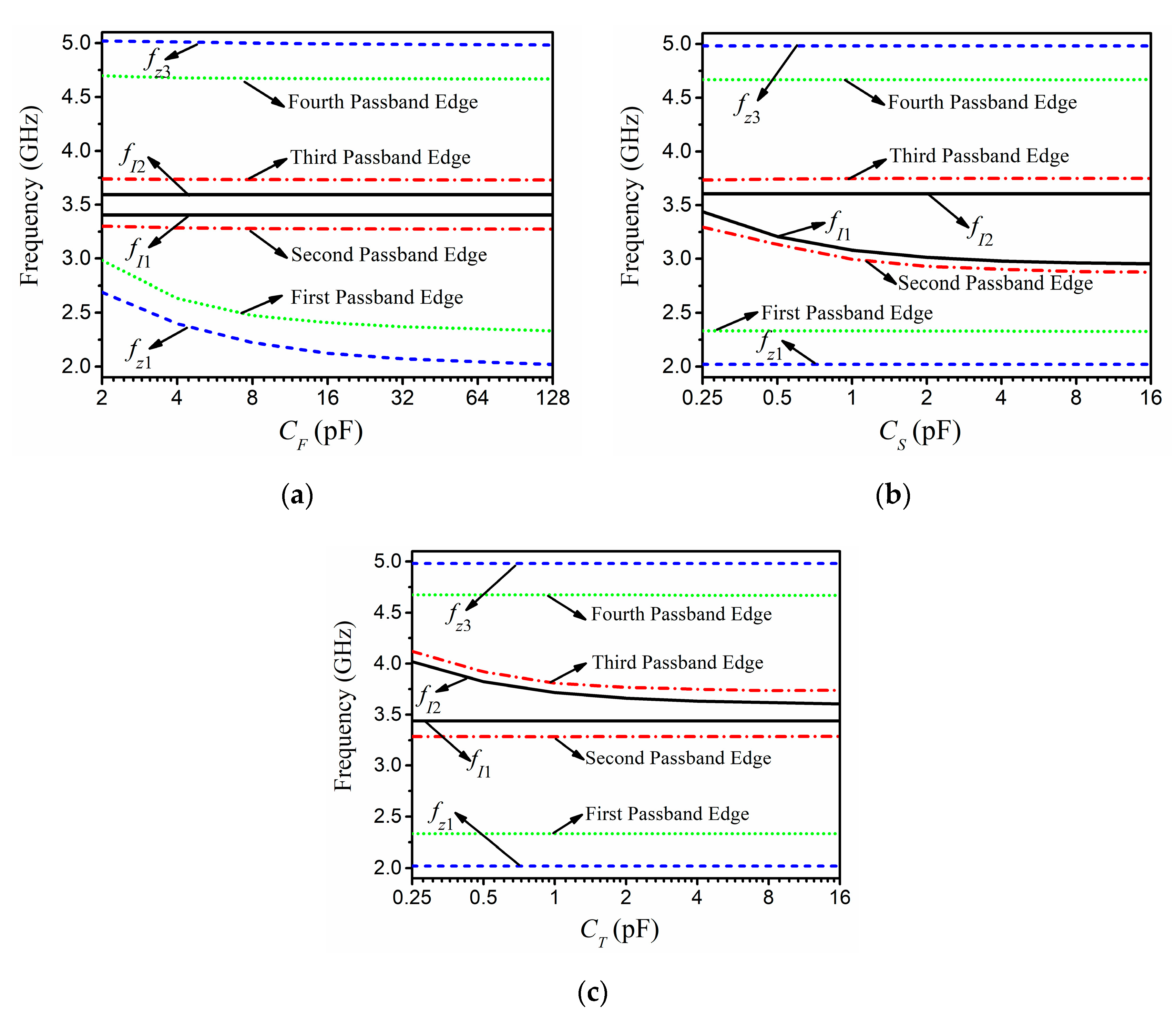

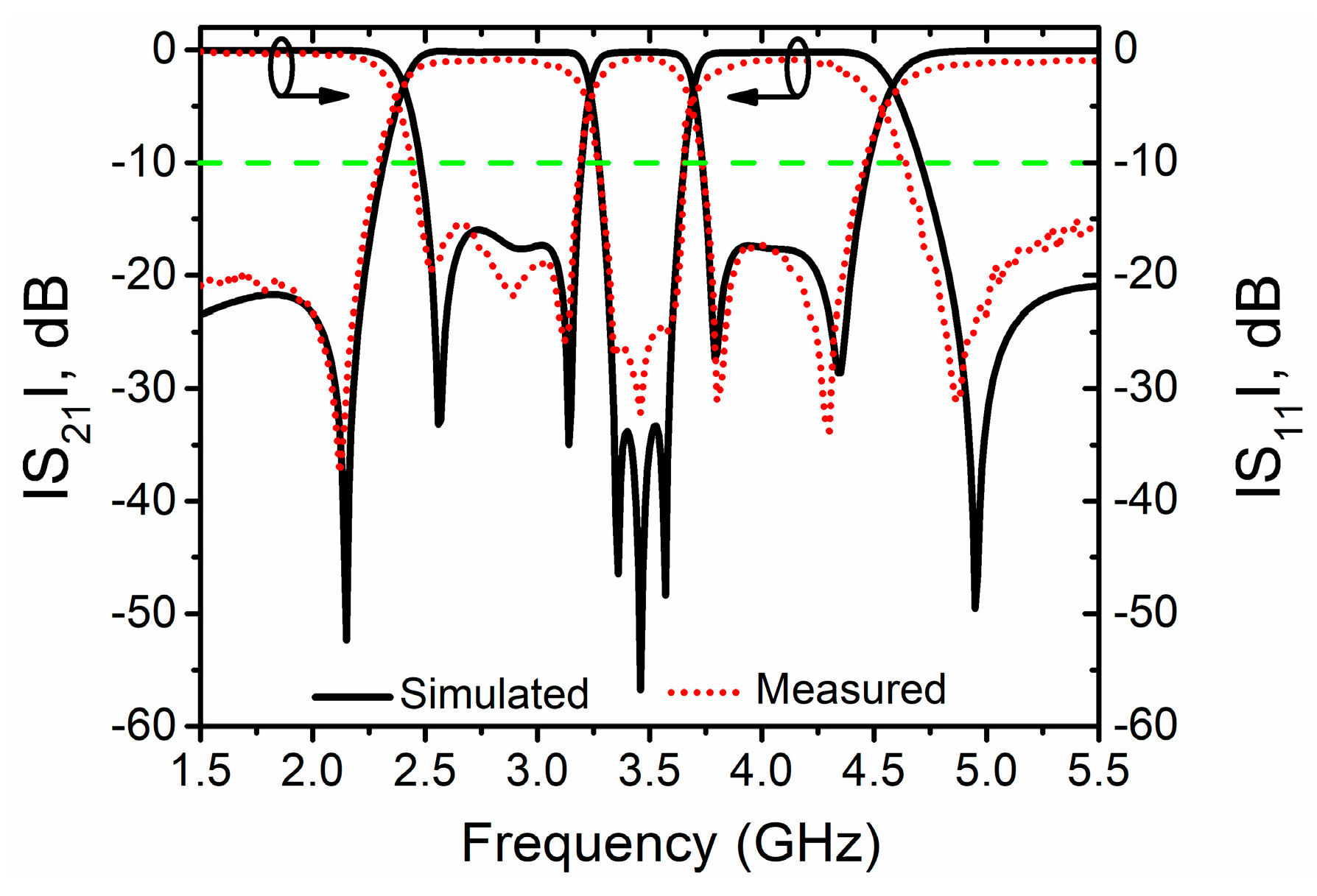

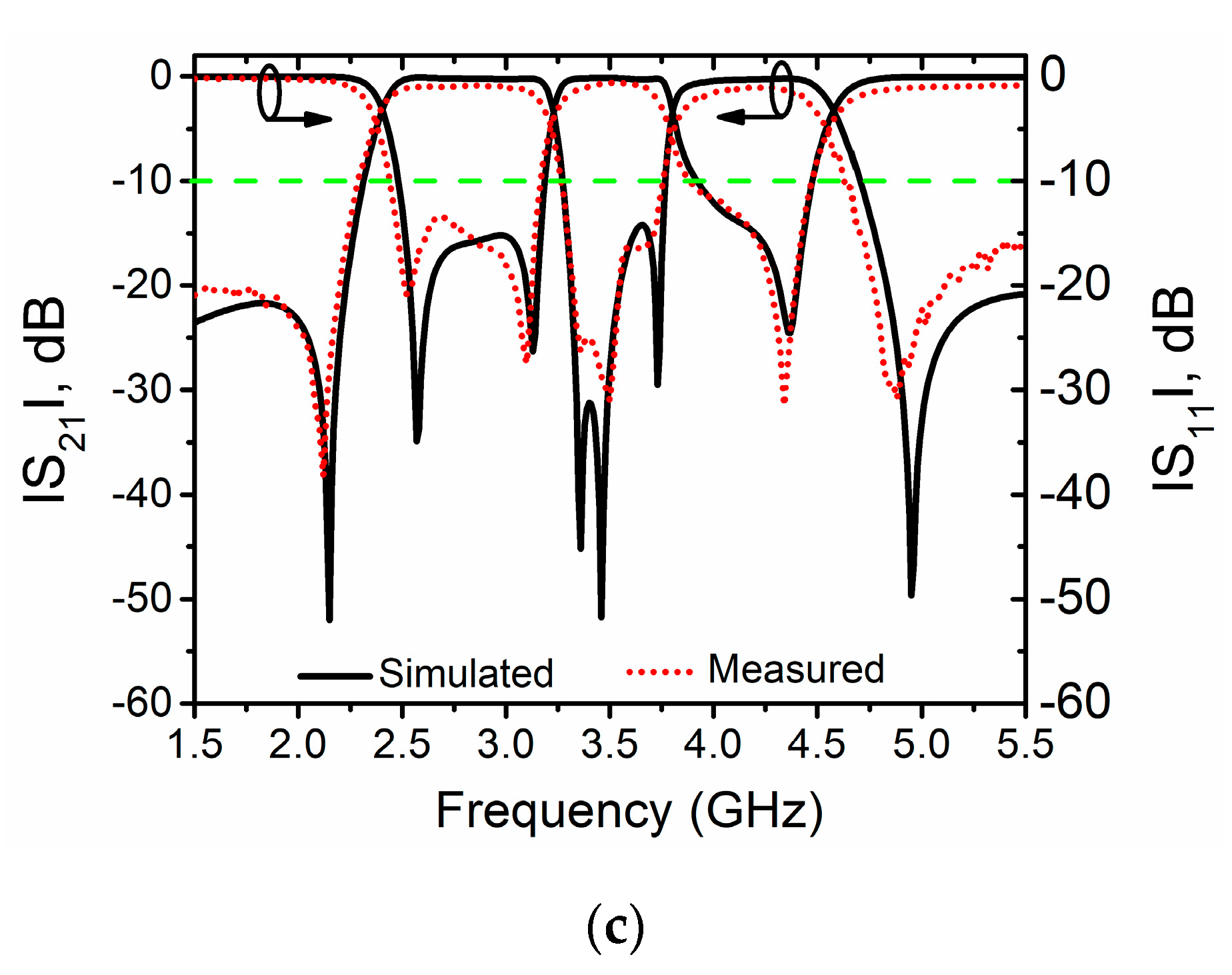
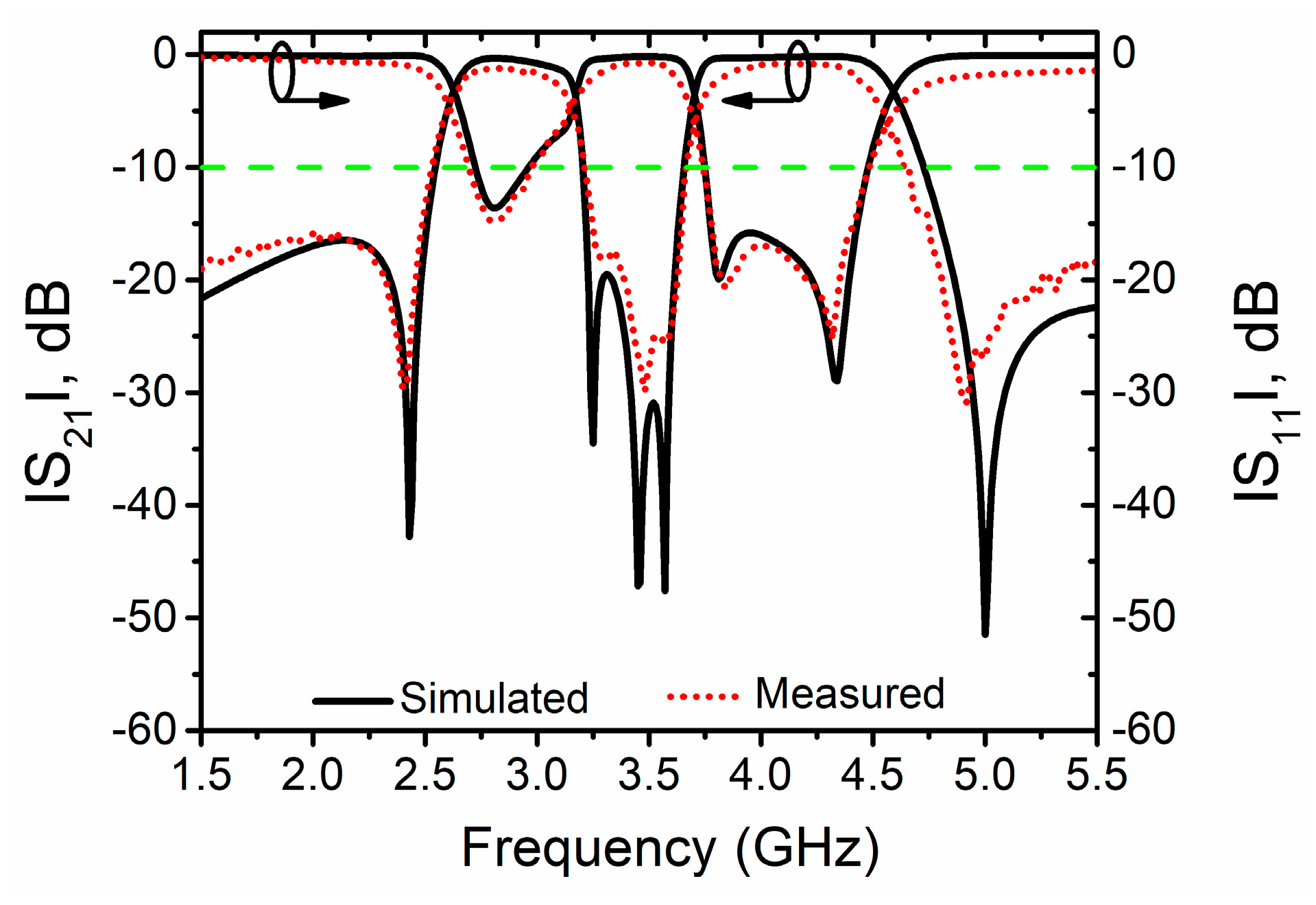

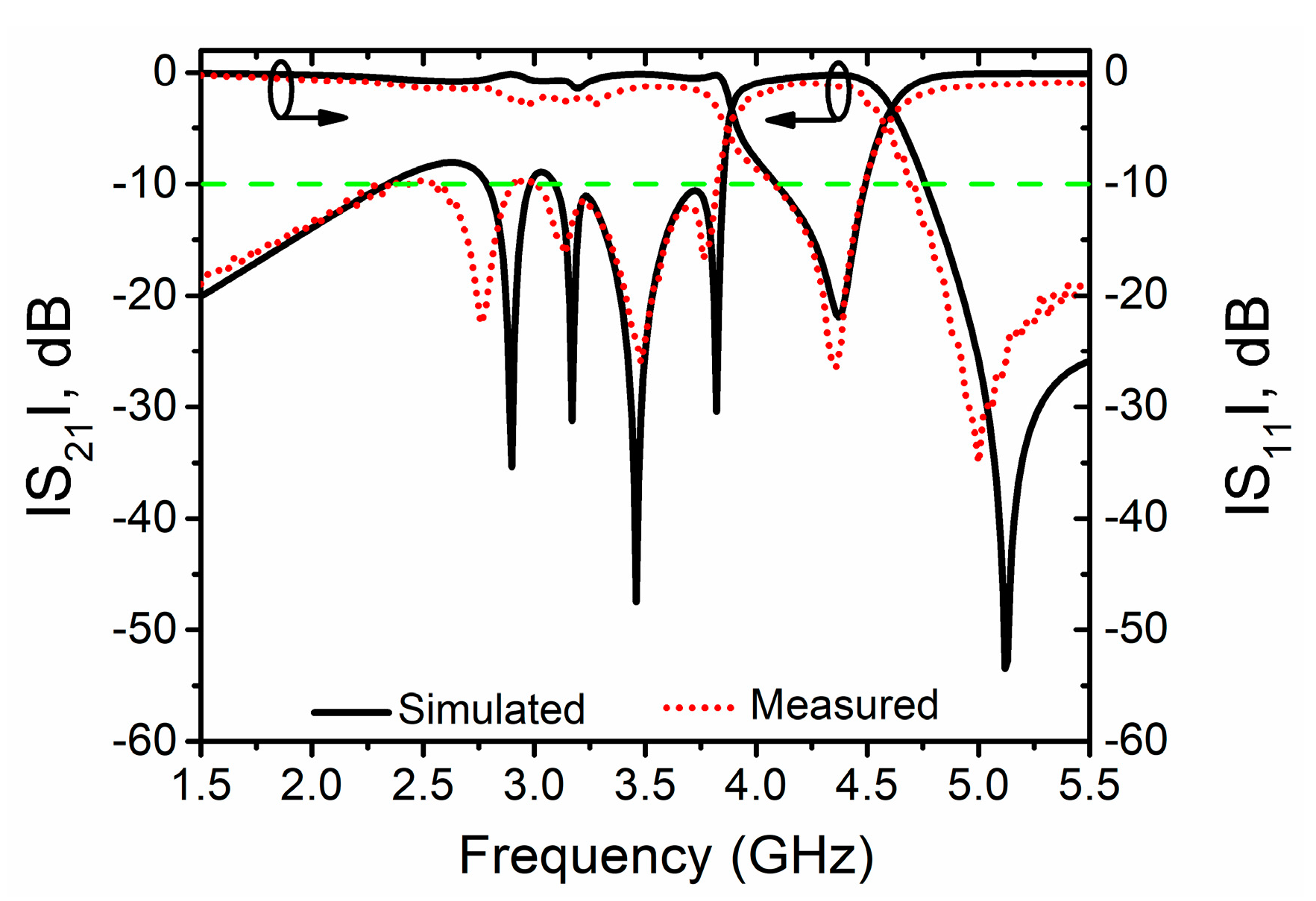
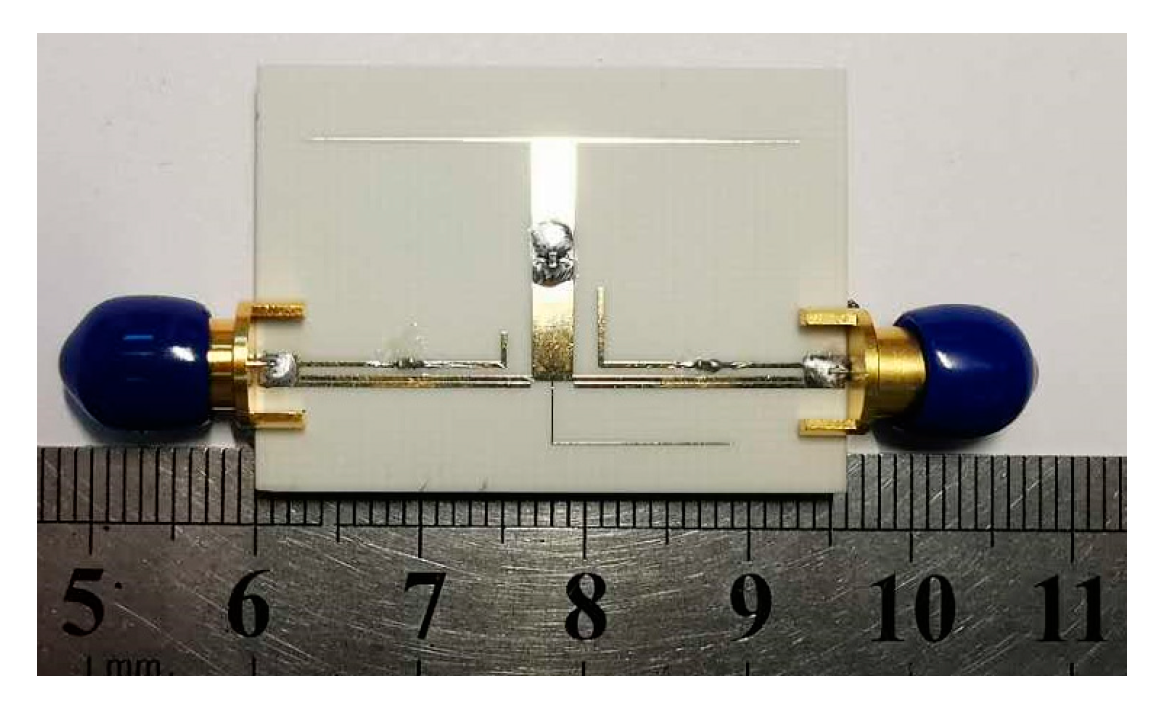
| Lower Passband | Upper Passband | Lower Passband | Upper Passband | ||||||||
|---|---|---|---|---|---|---|---|---|---|---|---|
| First 1 | Second 2 | Third 3 | Fourth 4 | First 1 | Second 2 | Third 3 | Fourth 4 | ||||
| Case A | Simulated | 2.48 GHz | 3.20 GHz | 3.74 GHz | 4.48 GHz | Case E | Simulated | 2.73 GHz | 2.96 GHz | 3.75 GHz | 4.48 GHz |
| Measured | 2.44 GHz | 3.19 GHz | 3.73 GHz | 4.46 GHz | Measured | 2.70 GHz | 2.98 GHz | 3.74 GHz | 4.48 GHz | ||
| Case B | Simulated | 2.75 GHz | 3.21 GHz | 3.74 GHz | 4.48 GHz | Case F | Simulated | N/A | N/A | 3.78 GHz | 4.49 GHz |
| Measured | 2.73 GHz | 3.21 GHz | 3.75 GHz | 4.49 GHz | Measured | N/A | N/A | 3.76 GHz | 4.51 GHz | ||
| Case C | Simulated | 2.48 GHz | 2.93 GHz | 3.75 GHz | 4.47 GHz | Case G | Simulated | N/A | N/A | 4.09 GHz | 4.49 GHz |
| Measured | 2.47 GHz | 2.96 GHz | 3.72 GHz | 4.48 GHz | Measured | N/A | N/A | 4.07 GHz | 4.49 GHz | ||
| Case D | Simulated | 2.48 GHz | 3.19 GHz | 3.92 GHz | 4.48 GHz | ||||||
| Measured | 2.44 GHz | 3.17 GHz | 3.89 GHz | 4.47 GHz | |||||||
| SWB BPFs | DWB BPFs | SWB BPFs | DWB BPFs | ||||||
|---|---|---|---|---|---|---|---|---|---|
| TBW 1 | TCF 2 | TBW 1 | SPB 3 | TBW 1 | TCF 2 | TBW 1 | SPB 3 | ||
| [9] | No | Yes | No | No | Filter B in [17] | No | Yes | No | Yes |
| [10] | No | Yes | No | No | Filter B in [20] | No | No | Yes | No |
| [12] | Yes | No | No | No | Filter B in [22] | No | Yes | Yes | No |
| [13] | Yes | No | No | No | This work | Yes | Yes | Yes | Yes |
| [16] | No | No | No | Yes | |||||
Publisher’s Note: MDPI stays neutral with regard to jurisdictional claims in published maps and institutional affiliations. |
© 2020 by the authors. Licensee MDPI, Basel, Switzerland. This article is an open access article distributed under the terms and conditions of the Creative Commons Attribution (CC BY) license (http://creativecommons.org/licenses/by/4.0/).
Share and Cite
Bi, X.; Guo, S.; Zhong, Z.; Hong, K.; He, W.; Yuan, T. Reconfigurable Single-/Dual-Wideband Bandpass Filters Based on a Novel Topology. Electronics 2020, 9, 2149. https://doi.org/10.3390/electronics9122149
Bi X, Guo S, Zhong Z, Hong K, He W, Yuan T. Reconfigurable Single-/Dual-Wideband Bandpass Filters Based on a Novel Topology. Electronics. 2020; 9(12):2149. https://doi.org/10.3390/electronics9122149
Chicago/Turabian StyleBi, Xiaokun, Shaohua Guo, Zengpei Zhong, Kaidong Hong, Wei He, and Tao Yuan. 2020. "Reconfigurable Single-/Dual-Wideband Bandpass Filters Based on a Novel Topology" Electronics 9, no. 12: 2149. https://doi.org/10.3390/electronics9122149




